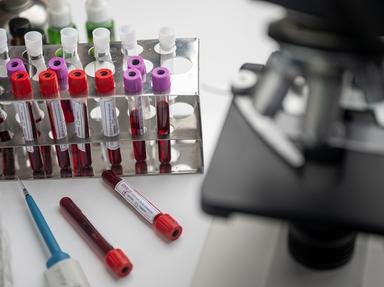Quiz Answer Key and Fun Facts
1. In structural biology, few techniques match this one in terms of resolution. It involves firing electromagnetic radiation at protein crystals and has solved several protein structures to atomic detail. What is this technique?
2. Ultraviolet circular dichroism (CD) is a spectroscopic technique used to analyse protein structure. The "far" version of this technique can tell us about the secondary structure of a protein. What two types of structure make up a protein's secondary structure?
3. This next technique is useful in identifying chemical groups of compounds. The basis of this technique is to fire electromagnetic radiation of slightly longer wavelength than visible light at a sample and to measure the absorption patterns. Which analytical technique is this?
4. If you have an unknown protein, you can digest it using a known enzyme (such as trypsin). The fragment pattern produced is unique to that protein and can be analysed using mass spectrometry. What is the name given to the unique set of fragments produced?
5. Proteins invariably interact with at least one other component in cells. This information can be utilised in order to separate the desired protein from other proteins in a cell lysate. Which technique involves passing a cell lysate through a column which contains groups known to specifically bind to a certain protein?
6. Since proteins are coded for by genes, genes may be sequenced and the protein sequence would follow. However, only parts of the mRNA (which carry the gene's code) actually code for the protein, with other stretches of nucleic acid interrupting the coding regions. What name is given to these coding regions?
7. If I want to know how much protein there is in a sample of mine, I may pick up a red liquid and put a few drops into my sample. After being added, the red liquid becomes blue. The "blueness" of the mixture is proportional to the concentration of the protein in the sample. What name is given to the red liquid?
8. In isoelectric focussing, gel electrophoresis is used to separate small molecules on the basis of charge. Which of the following is most important when performing isoelectric focussing?
9. If you wish to examine the function of a protein, you may perform in vitro experiments which use only specific protein components in order to deduce which are sufficient for a particular process to occur. What is this type of experiment called?
10. A compound known as ANS does not fluoresce in polar environments, but does in hydrophobic environments. Proteins tend to have hydrophobic interiors. However, fully folded proteins are often too compact for ANS to freely diffuse into the centre. ANS can, however, diffuse into the interior of partially folded proteins which possess secondary structure, but no appreciable tertiary structure. What name is given to these types of proteins?
Source: Author
doublemm
This quiz was reviewed by FunTrivia editor
WesleyCrusher before going online.
Any errors found in FunTrivia content are routinely corrected through our feedback system.
